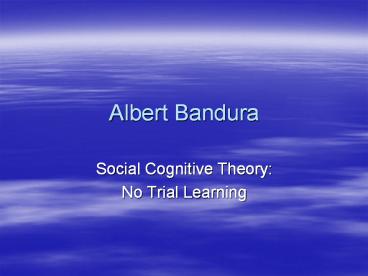Albert Bandura - PowerPoint PPT Presentation
Title:
Albert Bandura
Description:
Albert Bandura Social Cognitive Theory: No Trial Learning How is Bandura different from Skinner? How did Bandura extend Skinner's theory of Operant Conditioning? – PowerPoint PPT presentation
Number of Views:450
Avg rating:3.0/5.0
Title: Albert Bandura
1
Albert Bandura
- Social Cognitive Theory
- No Trial Learning
2
- How is Bandura different from Skinner?
- How did Bandura extend Skinner's theory of
Operant Conditioning? - How do Skinner and Bandura differ on
reinforcement?
3
Banduras Beliefs
- 1. Infants possess a collection of innate
reflexes - 2. Humans are capable of using symbols to
internalize (may include both rational judgments
and irrational beliefs) - 3. Humans have a capacity for forethought
(explains how goals influence behavior)
individuals are capable of anticipating and
behavior is reflective of this anticipation.
This explains how individuals demonstrate new
behavior when not a part of their personal
history.
4
Banduras Beliefs (cont.)
- 4. Individuals learn vicariously (by observation)
- this is the extension of Skinner - 5. Individuals are capable of reflection of their
own thoughts thus learning based upon thought
rather than direct experience.
5
Problems for Study
- The effects of
- observational learning,
- inhibition/disinhabition (based upon the
situation - sitting up straight when the
teacher is near or children who begin talking
more at bedtime), - response facilitation (a function of the behavior
of others - peer pressure), - environmental enhancement (children will fight
more if they observe parents fighting).
6
Internal Principles
- Triadic Reciprocality
- Behavior
- Environment
- Individuals Personal Beliefs
7
Bridge Principles
- Differential Contributions (relative importance
at any given time of each factor within Triadic
Reciprocality) - the environment may be extra important (peer
group in High School) - one's personality may influence the choice of
tasks and behaviors (cognition and personal
factors) - the model may be being reinforced for
"appropriate" (as seen by the individual)
behavior how close is this person to me in
terms of sex age race etc.
8
Bridge Principles (Cont.)
- 2. Temporal Dynamics - how the Triadic effects
work over time. Gradually or immediately
(consideration of other's feelings or group
glee) - 3. Fortuitous Determinants - the effects of
chance
9
Change Mechanisms
- 1. Acquisition - Attention and Retention
- Attention -
- for learning to occur, individuals must pay
attention and perceive (I chose Joe Namath and
behaved like some of his behaviors - white
football shoes, long hair, knee brace - but not
all of Joe's behavior was modeled, late nights,
alcohol) - IN SHORT We choose models who are
influential
10
Change Mechanisms (cont.)
- Retention - (how we commit events (attention) to
memory) - Symbolic Transformations. These confer
personal meanings to events. (Joe Namath was
someone to model because he was a QB, got girls
and was popular. I wanted to be the same) - imaginal - I imagine I'm Joe Namath
- linguistic - talking about and like Joe Namath
and his methods of behavior - rehearsal - practice - behaving like Joe Namath
as often as possible
11
Change Mechanisms (cont.)
- 2. performance - Production and
Motivation - you may acquire and retain new behavior, but
performance requires a reason. Its based upon
an individuals cognitive abilities in short --
we need a reason. Its all about motivation.































